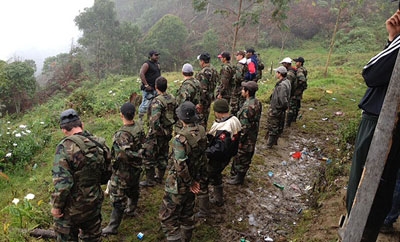With the demobilization of 17 fighters in Valle del Cauca and hundreds more possibly to surrender, there are indications that the Rastrojos drug gang, once Colombia‘s most powerful, is imploding after the surrender and capture of top leaders.
Seventeen camouflaged, armed members of the Rastrojos emerged from their encampment in the Garrapatas Canyon early on October 22, to hand themselves over to authorities in the village of La Sonora, Valle del Cauca province, reported El Pais.
The demobilization had been organized following the surrender of Rastrojos leader Javier Calle Serna, alias “Comba,” to US authorities in May this year. According to Semana, as part of the deal he brokered, Comba agreed to help authorities dismantle the criminal group.
This is the first demobilization of the Garrapatas Canyon group, which is estimated to be comprised of a little over 100 fighters. The group protects cocaine laboratories and key drug trafficking corridors that run towards the Pacific coast. Its remaining fighters are reportedly due to surrender in the coming weeks.
In 2009, 112 member of the Rastrojos demobilized in the Pacific province of Choco. Reports have swirled in recent months that a wave of surrenders is due to take place with El Tiempo declaring in August that 300 fighters were negotiating their submission. The newspaper also reported on October 22 that as part of the deal struck between Javier’s brother, Luis Enrique, and the US that facilitated his handover last month, 150 fighters have been promised to the authorities.
It is currently unclear if the Garrapatas Canyon unit comprises part of this total.
InSight Crime Analysis
In addition to the surrender of the Calle Serna brothers, the Rastrojos have also lost their military chief this year when Diego Perez Henao, alias “Diego Rastrojo,” was detained in Venezuela in June. Many predicted this would lead to the break up of the gang, something which appears to be happening.
One of the main factors that will bring about the Rastrojos’ downfall — on top of their disintegration through demobilization — is the incursion by stronger rival groups into their territory. Since 2011, the Urabeños have had a presence in the Rastrojos’ stronghold of Valle del Cauca, making alliances with drug running clan the Machos, and former Cali Cartel member, Victor Patiño. Now however, the Urabeños appear to be expanding and seeking to impose their dominance in the region, having been emboldened by the fall of the three Rastrojos leaders. A recent wave of killings in Valle del Cauca attests to this.
Due to the lack of leadership within the Rastrojos, the group is also faced with the threat of internal strife. Prior to his arrest, there were reports that Diego Rastrojo was commanding a faction against Comba due to a disagreement between the two over Comba’s decision to negotiate. This split has apparently endured since their respective detentions, with a number of killings attributed to warring factions taking place early last month in the northern and central parts of Valle del Cauca.
The Rastrojos’ numbers have declined by some 20 percent in recent years, leaving the group with around 1,600 fighters, according to Colombia’s police. If the latest demobilization is an indication of things to come, these numbers are set to decline further, leaving the group on the periphery of Colombia’s drug trade as others move in to take their place. It seems likely that the Urabeños will now seek to gobble up Rastrojos territory, to become the most powerful drug gang in the country, although they might face some competition from the Marxist rebels of the Revolutionary Armed Forces of Colombia (FARC) and the National Liberation Army (ELN).

